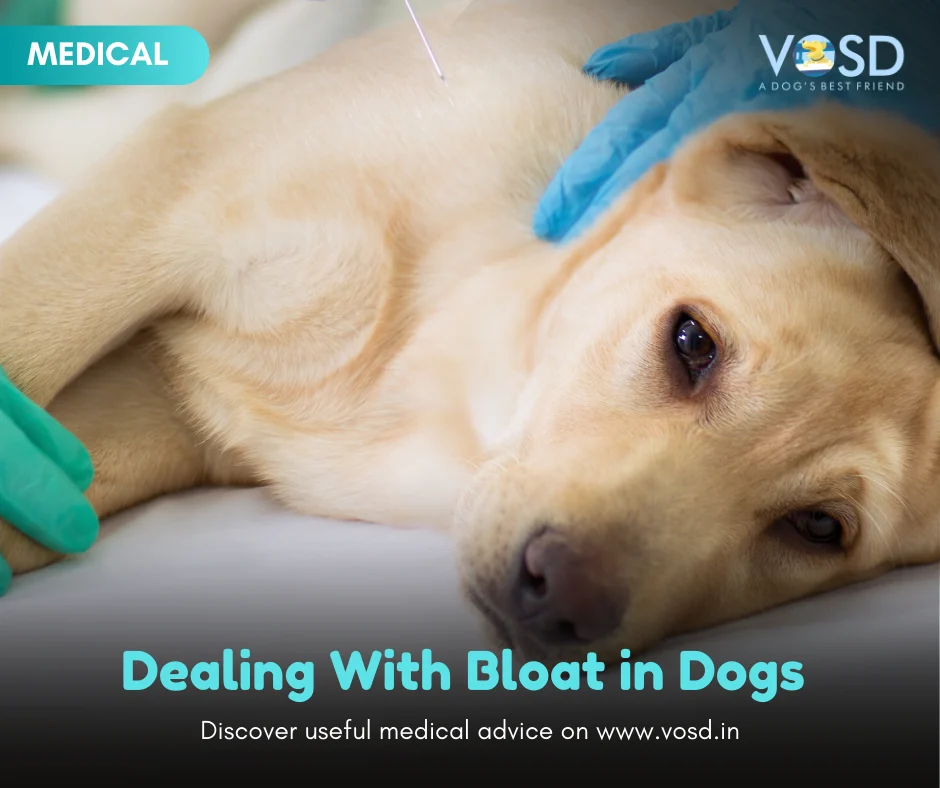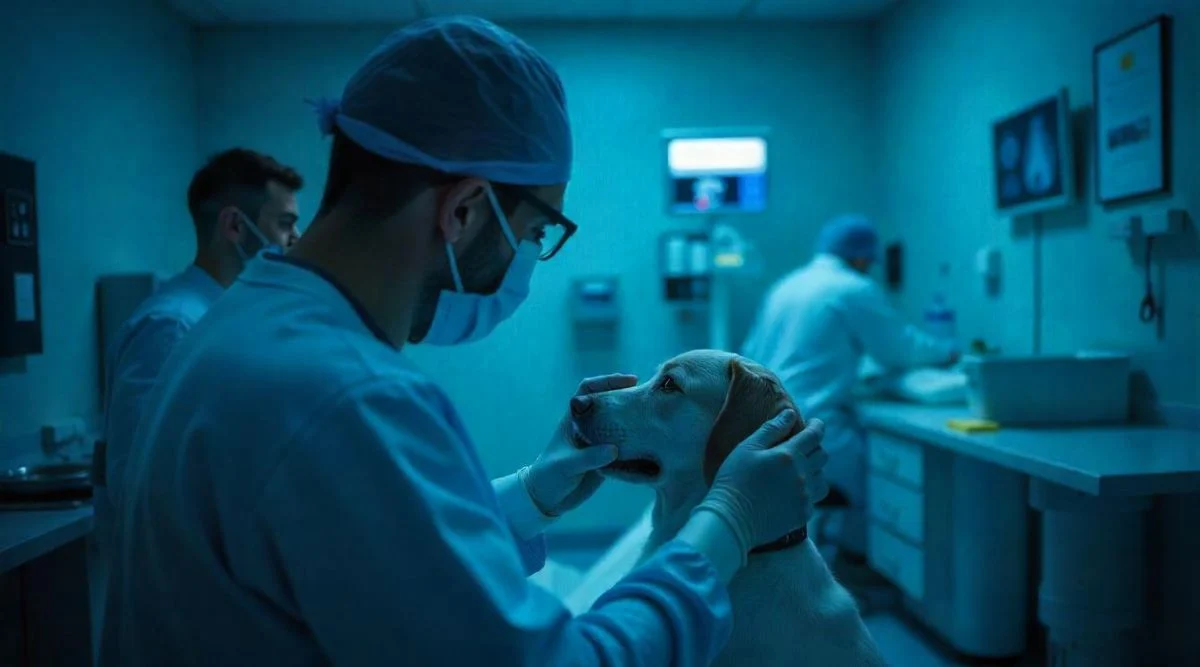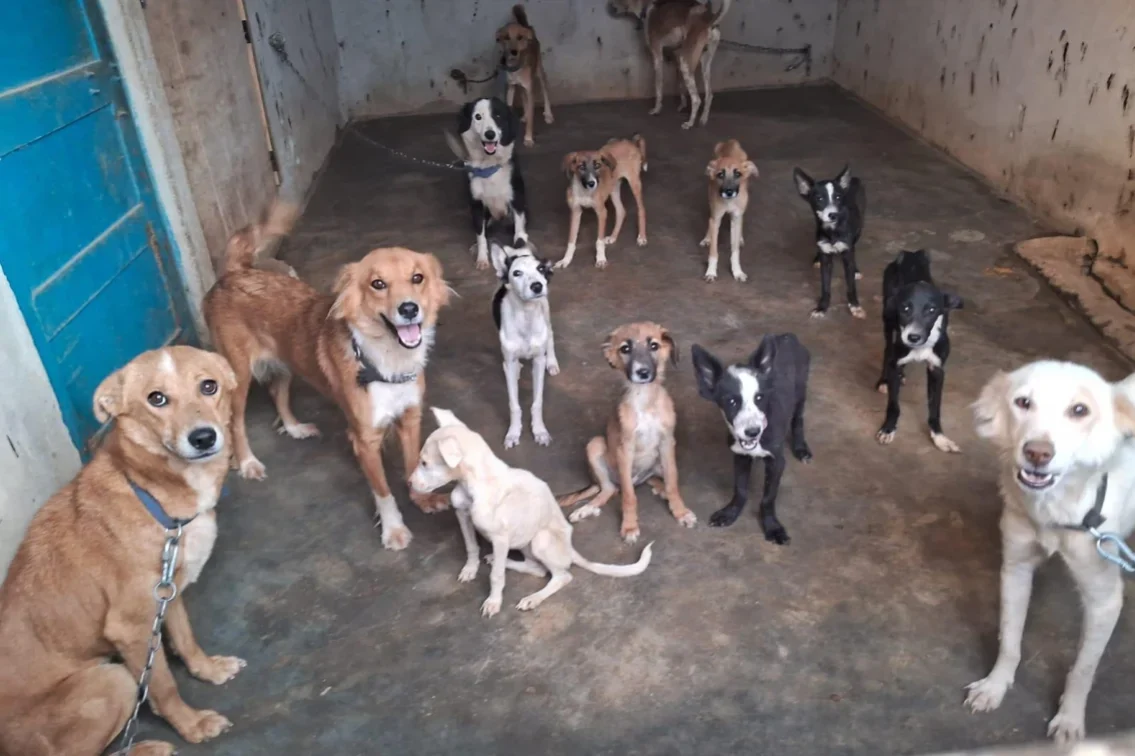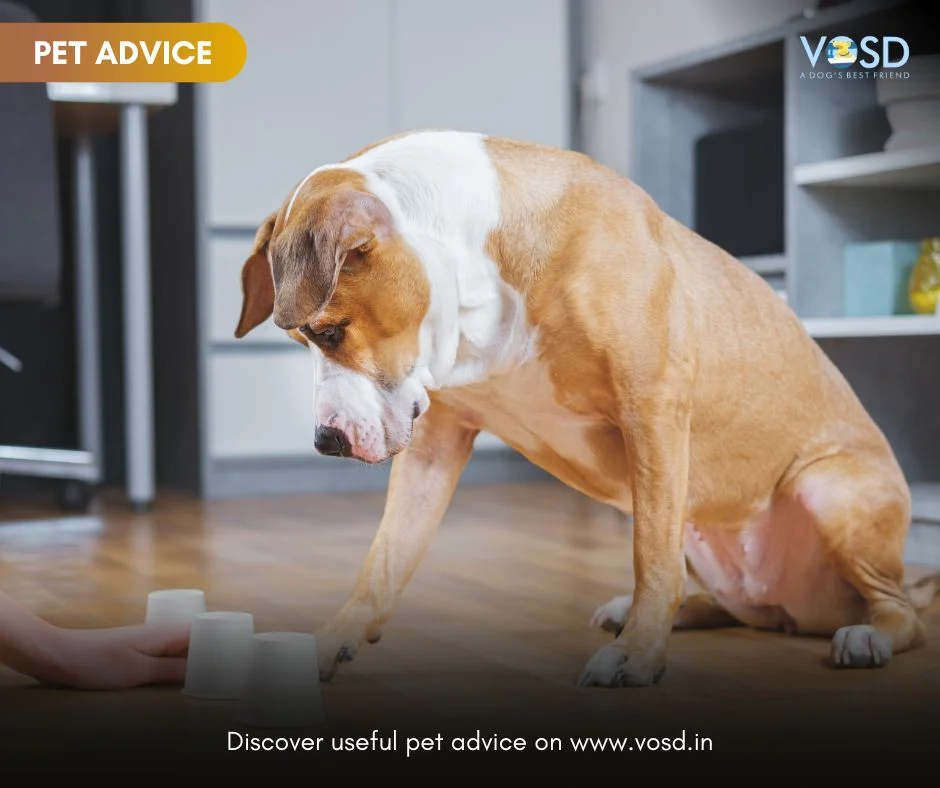Learn about a common but oft-ignored issue that dogs face- gastric bloat.
Bloat is technically called Gastric Dilation and Volvulus syndrome (GDV) but will be referred to as bloat in this article. VOSD has treated hundreds of dogs with bloat as part of our rescue and for the dogs that live at the VOSD Sanctuary & Hospital. This article shares the accepted medical understanding as well as our practical experience with… bloat.
What is bloat?
Bloat is the condition when the dog’s stomach dilates and then rotates, or twists, around itself. This constriction then causes the stomach to fill with gas. Bloat is an emergency situation. As gaseous pressure builds up it becomes visible as distension of the stomach. As pressure builds blood flow to the body is constricted. As the pressure continues to build blood flow to the heart stops it will cause heart failure and then death. Typically for a large dog from the time, you notice the distention of the stomach to death is a period of 1-2 hrs.
Make a Change! Put a Smile!
VOSD has given 250,000+ state-of-the-art free treatments, and we continue to provide hundreds of treatments every day across India – You can also Put a Smile by sponsoring a dog for treatment – click to know more
Bloating in small dogs vs big dogs
The physiology of dogs plays a big part in how dogs deal with bloat. For example, dogs with a deep, narrow chest – like a St. Bernard or an Irish Setter – suffer from bloat more extremely than dogs with a wide chest.
Behaviours, such as eating and swallowing food too fast, also contribute to increased additions to bloat. Feeding a dog once a day can also increase the chance of bloat. You may have also experienced a gassy feeling if you don’t eat for hours at a time – it is important to know that just feeding a dog once a day is not enough!
Symptoms of bloat in dogs
If a dog suffers from bloat, the abdomen will become larger in appearance, and hard or stiff to the touch. The dog will have trouble breathing, and its stomach will become “twisted” and in need of immediate release.
Once bloat sets in the dog will show anxious behaviour, depression, excessive drooling, and vomiting since it is trying to cope with the abdominal pressure and lack of oxygen.
Fast heart rate – the dog’s heart rate will be faster than normal, which is a sign of stress. If it becomes slow, it is a sign of shock. Either way, time is of the essence.
Pacing restlessly – If your dog is moving around, looking restless, it is an early and important sign of bloat. It is trying to find some relief, and is unable to get it.
Salivating profusely – Nausea that happens with gastric bloat causes an excess of saliva production. You can read more about that in our article on vomiting in dogs.
Once bloat sets in the dog will show anxious behaviour, depression, excessive drooling, and vomiting since it is trying to cope with the abdominal pressure and lack of oxygen.
Stage 1 symptoms
This is when the dog starts pacing up and down with stomach discomfort. He or she salivates heavily and tries to vomit but this is unproductive dry heaving as nothing comes out. Vomiting without anything coming out is a key symptom of bloat.
Stage 2 symptoms
This includes extremely rapid heartbeat known as tachycardia, laboured breathing known as dyspnea, a weak pulse as the heart starts failing, and pale mucous membrane on the gums and eyelids as blood flow stops. The dog may by this time be recumbent.
Causes of bloat
Unfortunately, the causes of bloat are unknown. Vets ascribe genetics and environment as the most likely reasons.
Large and giant-breed dogs, especially deep-chested breeds such as Great Danes, German Shepherds, and St Bernards are at higher risk.
Other factors may include the ingestion of excessive amounts of food or water in a short period and too much activity after eating, or a history of gastrointestinal tract problems.
In the VOSD Sanctuary experience, most cases were large or giant breed dogs, more often male than female, and middle-aged or young adults. Many of these dogs had a history of drinking or eating a large volume and then being excessively active. All cases occurred when their diet was a large part of the food volume made of kibble. Cases of bloat completely stopped when these dogs were moved to a non-kibble, more wet food diet. Cases have not been noticed in pups or old dogs of these breeds.
Emergency care: How long do you have to treat dog bloat?
Never treat a dog at home. It is of utmost importance that you take your dog to the emergency ward of a veterinarian hospital immediately. Time wasted by trying to relieve a dog’s stress is precious.
Bloat or GDV (twisted stomach) can kill a dog within an hour if untreated.
The dog’s veterinarian will provide immediate treatment to your dog, but if the local vet clinic is closed, go to an Animal Welfare ER quickly. The veterinarian will have to conduct a “gastropexy” surgery to untwist the abdomen.
What to do before, during, and after a case of bloat in dogs?
You will have to move very swiftly if you want to save the dog. While the hospital will take your dog for immediate treatment, there will be paperwork for you to fill out. For example, if your dog suffers from a cardiac arrest, you will have to provide permission to the hospital to resuscitate your dog.
Once this immediate treatment for dog bloated stomach is done, you can start to plan out how you will deal with the aftermath. This is the time to observe your dog for other signs. keep the dog in a small, confined space to prevent it from moving around and undoing the work of the surgery. The surgical procedure needs time to heal.
Diagnosis – how to check for bloat in dogs
A primary method of diagnosing bloat is imaging techniques, such as X-rays of the abdomen. However, the quickest way to determine bloat is by checking for stomach distention.
The best way to determine bloat is to make the dog lie down (if it is not lying down already) on its side (not its haunches). The dog will typically want to lie on one side, not on the other. With your palm feel if the stomach is distended. Typically this distention is below the rib cage on the soft underbelly to one side.
Veterinary treatment
Bloat is an emergency condition requiring you to take the dog to a vet immediately. If secondary cardiovascular problems have occurred they will need to be immediately treated. The vets will perform gastric decompression with orogastric intubation – passing a tube through the mouth into the stomach. If X-rays show organ entanglement surgery may be required to return internal organs (such as the stomach and spleen) to their normal positions.
Emergency treatment
Even with all the treatment available, up to 50% of the dogs will die at the vet clinic. Most of the time your dog’s best bet will be if the symptoms are Stage 2 and you clearly establish bloat with a physical inspection AND if you do not have help with a vet within a half-hour period.
Procedure
What you need is a 10ml syringe and some gauze and cotton.
Make the dog lie on its side, have someone hold the dog by the neck if required.
Trace a line from below the ribs to the dog’s thigh – you will find the distention here. This distention is not just a swelling but a tight pocket of air. If you pat it with your palm bounces back and makes a dull sound.
Take the needle and the syringe out from the packing.
Put the needle on the syringe tightly. Remove the needle cover. Remove the plunger of the syringe the back of the syringe needs to be open to allow the air to rush out and the fluid to collect.
Insert the needle into this tight bubble in one swift motion.
Before doing so remember to have the back of the syringe point away from you- since the gas will come out with some fluid rather explosively.
Keep the needle perpendicular to the stomach. Do not hesitate- push the needle holding the cylinder of the syringe for a firm grip so as to not let go of the needle – gas and some stomach fluid will come out explosively like a spray.
Once that happens keep the needle in place and gently apply pressure where the air pocket was to ensure any other air is expelled.
Pull out the needle. The puncture is almost painless and the puncture in the outside and inside in the stomach will close itself.
Clean the dog and the area with gauze.
The dog will get up as the pressure is relieved and will act ‘normal’. However, as mentioned earlier there could be twisted organs and the dog will need an inspection and an x-ray. You’ve saved the dog’s life but he/she is not out of danger yet.
Keep the dog secure and take the dog to the vet immediately. Get Vet Advice for Dogs from VOSD.
How can bloat be prevented?
Veterinary recommendations for the prevention of bloat and that have worked for our dogs include:
● Slowing the rate of food consumption for large breeds
● Several smaller meals, rather than infrequent larger portions
● Avoiding strenuous exercise after eating and drinking
● Not feeding from an elevated food bowl
● Avoiding dry kibble
● Offering water at all times
Moving the food away from kibble and feeding at ground level has completely eliminated bloat incidents at the VOSD Sanctuary & Hospital.
Frequently Asked Questions(FAQ)
1. What are the first signs of bloat in a dog?
Bloating in dogs is life-threatening and should be treated immediately. The first signs start with an enlarged and distended abdomen, followed by an anxious and distressed behavior. Symptoms of bloat in dogs will include vomiting, increased heart rate, excessive salivation and drooling. You need to rush your dog to a vet immediately.
2. What would cause a dog’s stomach to bloat?
Bloating in dogs is usually caused when they intake a large amount of food too fast or engage in excessive physical activity after a meal. Many times, eating kibble also leads to bloating. Dogs with gastrointestinal tract problems or genetic defects are most likely to get it. German shepherds, Great Danes and other large breed dogs are at a higher risk.
3. How do you treat bloat in dogs?
Bloating in dogs should never be treated at home. You should immediately take your dog to the vet for a surgical procedure that will involve untwisting the stomach to relieve the gastric pressure build-up. The time span from the occurrence of bloat to the dog’s death is within two hours so time is of the essence.
4. Can dog bloat resolve on its own?
Severe dog bloat cannot and should not be resolved on its own. Whenever you wonder, how to treat bloat in dogs, remember that it is relevant to a surgical procedure with a very small window. If it is not a simple case of gastric buildup, that might resolve without medical intervention. You must take the dog to the vet immediately if you suspect bloat!
5. How do I help my dog with bloat?
The best thing to do when your dog has bloat is to rush him to the hospital. However, there are some things you can do to avoid its occurrence in the first place and manage it post-surgery. Dog bloat remedy includes feeding the dog in small quantities with enough water on the side. Avoid foods with kibble. Also, make sure that the food is not kept at an elevated level. Post-surgery, you need to calm your dog and prevent him from being overly active for the surgery to heal.





